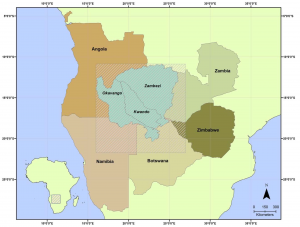
BUNTING, SOUTHWORTH, HERRERO, RYAN, WAYLEN – Understanding Long-Term Savanna Vegetation Persistence across Three Drainage Basins in Southern Africa
Erin L. Bunting , Jane Southworth, Hannah Herrero, Sadie J. Ryan, and Peter Waylen
Article first published online: 25 JUN 2018 Remote Sens. 2018, 10(7), 1013
DOI: 10.3390/rs10071013
ABSTRACT: Across savanna landscapes of southern Africa, people are strongly tied to the environment, meaning alterations to the landscape would impact livelihoods and socioecological development. Given the human–environment connection, it is essential to further our understanding of the drivers of savanna vegetation dynamics, and under increasing climate variability, to better understand the vegetation–climate relationship. Monthly time series of Advanced Very High-Resolution Radiometer (AVHRR)- and Moderate Resolution Imaging Spectroradiometer (MODIS) derived vegetation indices, available from as early as the 1980s, holds promise for the large-scale quantification of complex vegetation–climate dynamics and regional analyses of landscape change as related to global environmental changes. In this work, we employ time series based analyses to examine landscape-level vegetation greening patterns over time and across a significant precipitation gradient. In this study, we show that climate induced reductions in Normalized Difference Vegetation Index (NDVI; i.e., degradation or biomass decline) have had large spatial and temporal impacts across the Kwando, Okavango, and Zambezi catchments of southern Africa. We conclude that over time there have been alterations in the available soil moisture resulting from increases in temperature in every season. Such changes in the ecosystem dynamics of all three basins has led to system-wide changes in landscape greening patterns.
Read the full publication at Remote Sensing